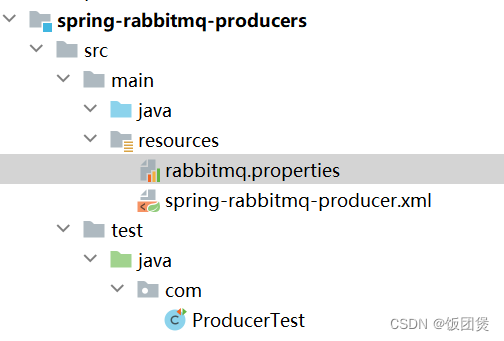一、步骤
生产者
① 创建生产者工程
② 添加依赖
③ 配置整合
④ 编写代码发送消息
消费者
① 创建消费者工程
② 添加依赖
③ 配置整合
④ 编写消息监听器
二、代码
生产者工程

1.在生产者工程和消费者工程中都导入如下依赖
<dependencies>
<dependency>
<groupId>org.springframework</groupId>
<artifactId>spring-context</artifactId>
<version>5.1.7.RELEASE</version>
</dependency>
<dependency>
<groupId>org.springframework.amqp</groupId>
<artifactId>spring-rabbit</artifactId>
<version>2.1.8.RELEASE</version>
</dependency>
<dependency>
<groupId>junit</groupId>
<artifactId>junit</artifactId>
<version>4.12</version>
</dependency>
<dependency>
<groupId>org.springframework</groupId>
<artifactId>spring-test</artifactId>
<version>5.1.7.RELEASE</version>
</dependency>
</dependencies>
<build>
<plugins>
<plugin>
<groupId>org.apache.maven.plugins</groupId>
<artifactId>maven-compiler-plugin</artifactId>
<version>3.8.0</version>
<configuration>
<source>1.8</source>
<target>1.8</target>
</configuration>
</plugin>
</plugins>
</build>
2.生产者和消费者 导入配置文件 rabbitmq.properties
rabbitmq.host=43.143.246.208
rabbitmq.port=5672
rabbitmq.username=root
rabbitmq.password=root
rabbitmq.virtual-host=/itcast
3.生产者核心配置文件 spring-rabbitmq-producer.xml
<?xml version="1.0" encoding="UTF-8"?>
<beans xmlns="http://www.springframework.org/schema/beans"
xmlns:xsi="http://www.w3.org/2001/XMLSchema-instance"
xmlns:context="http://www.springframework.org/schema/context"
xmlns:rabbit="http://www.springframework.org/schema/rabbit"
xsi:schemaLocation="http://www.springframework.org/schema/beans
http://www.springframework.org/schema/beans/spring-beans.xsd
http://www.springframework.org/schema/context
https://www.springframework.org/schema/context/spring-context.xsd
http://www.springframework.org/schema/rabbit
http://www.springframework.org/schema/rabbit/spring-rabbit.xsd">
<!--加载配置文件-->
<context:property-placeholder location="classpath:rabbitmq.properties"/>
<!-- 定义rabbitmq connectionFactory -->
<rabbit:connection-factory id="connectionFactory" host="${rabbitmq.host}"
port="${rabbitmq.port}"
username="${rabbitmq.username}"
password="${rabbitmq.password}"
virtual-host="${rabbitmq.virtual-host}"/>
<!--定义管理交换机、队列-->
<rabbit:admin connection-factory="connectionFactory"/>
<!--定义持久化队列,不存在则自动创建;不绑定到交换机则绑定到默认交换机
默认交换机类型为direct,名字为:"",路由键为队列的名称
-->
<rabbit:queue id="spring_queue" name="spring_queue" auto-declare="true"/>
<!-- ~~~~~~~~~~~~~~~~~~~~~~~~~~~~广播;所有队列都能收到消息~~~~~~~~~~~~~~~~~~~~~~~~~~~~ -->
<!--定义广播交换机中的持久化队列,不存在则自动创建-->
<rabbit:queue id="spring_fanout_queue_1" name="spring_fanout_queue_1" auto-declare="true"/>
<!--定义广播交换机中的持久化队列,不存在则自动创建-->
<rabbit:queue id="spring_fanout_queue_2" name="spring_fanout_queue_2" auto-declare="true"/>
<!--定义广播类型交换机;并绑定上述两个队列-->
<rabbit:fanout-exchange id="spring_fanout_exchange" name="spring_fanout_exchange" auto-declare="true">
<rabbit:bindings>
<rabbit:binding queue="spring_fanout_queue_1"/>
<rabbit:binding queue="spring_fanout_queue_2"/>
</rabbit:bindings>
</rabbit:fanout-exchange>
<!-- ~~~~~~~~~~~~~~~~~~~~~~~~~~~~通配符;*匹配一个单词,#匹配多个单词 ~~~~~~~~~~~~~~~~~~~~~~~~~~~~ -->
<!--定义广播交换机中的持久化队列,不存在则自动创建-->
<rabbit:queue id="spring_topic_queue_star" name="spring_topic_queue_star" auto-declare="true"/>
<!--定义广播交换机中的持久化队列,不存在则自动创建-->
<rabbit:queue id="spring_topic_queue_well" name="spring_topic_queue_well" auto-declare="true"/>
<!--定义广播交换机中的持久化队列,不存在则自动创建-->
<rabbit:queue id="spring_topic_queue_well2" name="spring_topic_queue_well2" auto-declare="true"/>
<rabbit:topic-exchange id="spring_topic_exchange" name="spring_topic_exchange" auto-declare="true">
<rabbit:bindings>
<rabbit:binding pattern="root.*" queue="spring_topic_queue_star"/>
<rabbit:binding pattern="root.#" queue="spring_topic_queue_well"/>
<rabbit:binding pattern="itcast.#" queue="spring_topic_queue_well2"/>
</rabbit:bindings>
</rabbit:topic-exchange>
<!--定义rabbitTemplate对象操作可以在代码中方便发送消息-->
<rabbit:template id="rabbitTemplate" connection-factory="connectionFactory"/>
</beans>
4.测试类 ProducerTest
@RunWith(SpringJUnit4ClassRunner.class)
@ContextConfiguration(locations = "classpath:spring-rabbitmq-producer.xml")
public class ProducerTest {
//1.注入 RabbitTemplate
@Autowired
private RabbitTemplate rabbitTemplate;
@Test
public void testHelloWorld(){
//2.发送消息
rabbitTemplate.convertAndSend("spring_queue","hello world spring....");
}
/**
* 发送fanout消息
*/
@Test
public void testFanout(){
//2.发送消息
rabbitTemplate.convertAndSend("spring_fanout_exchange","","spring fanout....");
}
/**
* 发送topic消息
*/
@Test
public void testTopic(){
//2.发送消息
rabbitTemplate.convertAndSend("spring_topic_exchange","root.hehe.haha","spring topic....");
}
}
5.运行结果

消费者工程
1、2同上述1、2
3、消费者核心配置文件
<?xml version="1.0" encoding="UTF-8"?>
<beans xmlns="http://www.springframework.org/schema/beans"
xmlns:xsi="http://www.w3.org/2001/XMLSchema-instance"
xmlns:context="http://www.springframework.org/schema/context"
xmlns:rabbit="http://www.springframework.org/schema/rabbit"
xsi:schemaLocation="http://www.springframework.org/schema/beans
http://www.springframework.org/schema/beans/spring-beans.xsd
http://www.springframework.org/schema/context
https://www.springframework.org/schema/context/spring-context.xsd
http://www.springframework.org/schema/rabbit
http://www.springframework.org/schema/rabbit/spring-rabbit.xsd">
<!--加载配置文件-->
<context:property-placeholder location="classpath:rabbitmq.properties"/>
<!-- 定义rabbitmq connectionFactory -->
<rabbit:connection-factory id="connectionFactory" host="${rabbitmq.host}"
port="${rabbitmq.port}"
username="${rabbitmq.username}"
password="${rabbitmq.password}"
virtual-host="${rabbitmq.virtual-host}"/>
<!-- 定义SpringQueueListener -->
<bean id="springQueueListener" class="com.rabbitmq.listener.SpringQueueListener"/>
<!-- <bean id="fanoutListener1" class="com.rabbitmq.listener.FanoutListener1"/>-->
<!-- <bean id="fanoutListener2" class="com.rabbitmq.listener.FanoutListener2"/>-->
<!-- <bean id="topicListenerStar" class="com.rabbitmq.listener.TopicListenerStar"/>-->
<!-- <bean id="topicListenerWell" class="com.rabbitmq.listener.TopicListenerWell"/>-->
<!-- <bean id="topicListenerWell2" class="com.rabbitmq.listener.TopicListenerWell2"/>-->
<rabbit:listener-container connection-factory="connectionFactory" auto-declare="true">
<!-- 定义SpringQueueListener 监听哪个队列-->
<rabbit:listener ref="springQueueListener" queue-names="spring_queue"/>
<!-- <rabbit:listener ref="fanoutListener1" queue-names="spring_fanout_queue_1"/>-->
<!-- <rabbit:listener ref="fanoutListener2" queue-names="spring_fanout_queue_2"/>-->
<!-- <rabbit:listener ref="topicListenerStar" queue-names="spring_topic_queue_star"/>-->
<!-- <rabbit:listener ref="topicListenerWell" queue-names="spring_topic_queue_well"/>-->
<!-- <rabbit:listener ref="topicListenerWell2" queue-names="spring_topic_queue_well2"/>-->
</rabbit:listener-container>
</beans>
4.类 SpringQueueListener
public class SpringQueueListener implements MessageListener {
@Override
public void onMessage(Message message) {
//打印消息
System.out.println(new String(message.getBody()));
}
}
5.测试
@RunWith(SpringJUnit4ClassRunner.class)
@ContextConfiguration(locations = "classpath:spring-rabbitmq-comsumer.xml")
public class ConsumerTest {
@Test
public void test1(){
boolean flag = true;
while (true){
}
}
}













